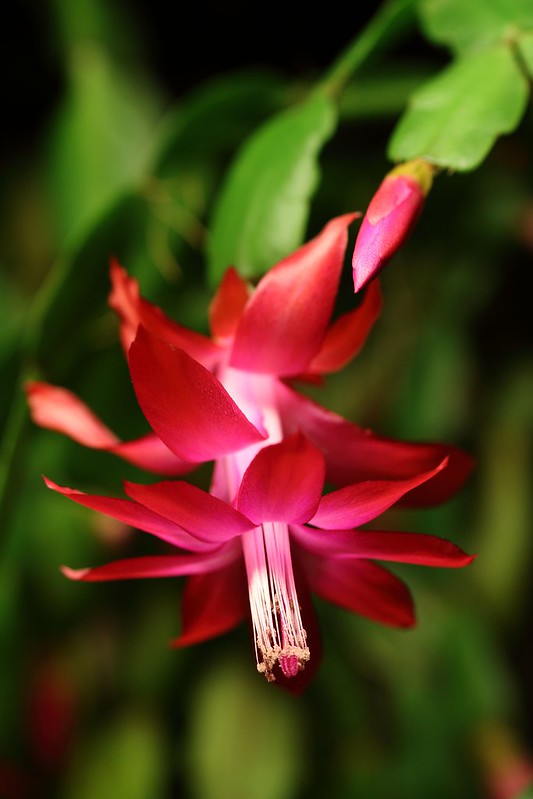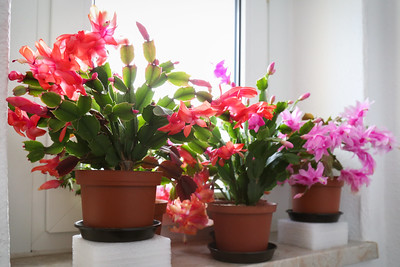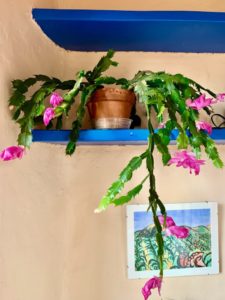Scientific genus name: Schlumbergera
Suggested pronunciation: schlum-BER-ger-uh
Common names: Christmas, Thanksgiving, Easter cactus

Photo credit: Flickr, “Cactus de Noël” by Jacques Mignon (CC BY 2.0).
Family: Cactaceae
Article by Jeanne Gozigian
We have written in the past of house plants that are forced to bloom at certain times, like amaryllis at Christmas time and paperwhites in the winter. So, too, can the Christmas cactus, which makes a lovely, always appreciated holiday gift. Because it is propagated so easily, this usually winter- flowering plant can be engineered to bloom at Easter or Thanksgiving, as well.
The tubular, 2.0” x 1.2- 1.6”, long- blooming flowers can occur in pink, purple, yellow, red and white colors, so work to denote many seasons. The natural habitat of these plants is as epiphytes, plants that grow on other plants but are not parasitic, not as typical cacti, on the branches of trees in the rain forests of Brazil; therefore, they require more water than most succulents, but do not like to have wet feet. That can cause root rot. Let them dry out between watering. Fertilize every other week. They will have more blooms in well- lit areas without direct sun; these are jungle natives!

Photo credit: Flickr, “Schlumbergera” by Maja Dumat (CC BY 2.0).
A good way to provide 60-70 percent humidity is to place your plants on a tray of pebbles filled with water. After flowering, reduce moisture, light and temperature to allow dormancy, with 12-14 hours of darkness in a temperature of 50-55 degrees.

Schlumbergera house plant. Photo: Lindsay Taylor.
The flattened, pad- like leaves, are actually photosynthesis producing, segmented stems, 1.5 inches long and 0.8” wide, typical of these members of the Cactaceae family. Christmas cacti (Schlumbergera bridgessii or russelliana) have flattened leaves with rounded teeth on their margins. The blossoms form in these notches or on the tips of the pads.
Thanksgiving cacti (Schlumbergera truncata – many so-called Christmas cacti- are this species) have leaves with pointed teeth. Easter cacti (Hatiora or Shlumbergera gaertneri) have rounded teeth and red, daisy-like, rather than tubular blossoms. Easter cacti require 8-12 weeks of short days to bloom, whereas Christmas and Thanksgiving cacti require 6 weeks.
The holiday cacti, as they are known, are also called leaf cacti. Plants have been passed down in generations of some families and can reach 100 years of age. This reminds me of an angel leaf begonia plant which originated with my maternal grandmother, cuttings of which are still going strong with some of her adult great-grandchildren!

Schlumbergera flowers. Photo by Lindsay Taylor.
Easy to care for, the Schlumbergera spp. are also fairly easy to propagate. Cut short, ¼” Y-shaped segments from healthy stem tips. Place in sandy soil and moisten evenly. Keep in filtered light. They actually like to be somewhat root bound and bloom best when they are. Wait to repot in clean soil when not in bloom. Problems are blossom drop, usually from too much light, wrong temperatures, too little or much water, root rot and mealy bugs. In an article written for the Santa Fe New Mexican, Jan Barbo said:
“The Christmas cactus is sensitive to changes in light, temperature and humidity, and it should be left in the same location once buds have formed. The buds are likely to fall off if it is turned or moved in any way. Yet I move mine to a prominent spot when it’s in full flower and accept the consequences.”
In the summertime, plants can be placed in shady spots in the garden. Unheated porches are good storage places until below 50 degrees F. Prune in June. To trigger bloom, keep in the dark for 14 hours and in daylight for 8-10 hours every day for 6 weeks. All are cultivars of one of two groups, the Truncata or Buckleyi group.
Sometimes called crab cactus, in Brazil they are called flor de Maio. In the wild of the southern hemisphere they usually bloom in the month of May. George Gardner, a Scottish biologist (1810-1849) interested in botany discovered the species in Brazil in 1837 and named russelliana for John Russell, the 6th British Duke of Bedford. Charles Lemaire, a French botanist (1800-1871), created the genus in 1838, commemorating Frederic Schlumberger of Belgium, who had a chateau with a famous collection of cacti near Rouen, France. The Schlumbergera species, cultivars and hybrids have either two series of pale pink stamens with pale pink pollen or yellow pollen. Our holiday cacti do not naturally occur in nature, but are bred from two unique parent plants from South American rain forests. Just think, their beauty is not only skin deep but romantic in origin!
Thanks to Helen Woody and Janice Tucker for proofreading this article.
Sources:
“Christmas Cactus, How to Care for Holiday Cacti”. The Old Farmer’s Almanac. Web. Accessed 15 Sept. 2020. Retrieved from: www.almanac.com/plant/christmas-cactus
Coxhead, Peter. “Origin of the generic name Schlumbergera”. Peter Coxhead: Personal Home Page. Web. 05 Dec 2011. Accessed 20 Oct 2020. Retrieved from: http://www.pxc.me.uk/misc/schlumbergera.html
“Easter Cactus”. Description, Distribution & Facts. Britannica. Web. 11 Jan 2018. Accessed 02 Oct 2020. Retrieved from: www.britannica.com/plant/Easter-cactus.
Harrison, Marie. “Thanksgiving Cactus”. Dave’s Garden. Web. 17 Nov. 2013. Accessed 01 Sept. 2020. Retrieved from: https://davesgarden.com/guides/articles/view/3472.
“Is it Thanksgiving, Christmas or Easter Cactus?” World of Succulents. Web. 28 Nov. 2018. Accessed 01 Sept. 2020. Retrieved from: https://worldofsucculents.com/thanksgiving-christmas-easter-cactus/
Tilley, Nikki. “How to Care for a Christmas Cactus Houseplant”. Gardening Know How. Web. 2020. Accessed 01 Sept. 2020. Retrieved from: https://www.gardeningknowhow.com/ornamental/cacti-succulents/christmas-cactus/advice-for-christmas-cactus-care.htm
“Schlumbergera”. Wikipedia. Web. 15 Sept 2020. Accessed 15 Sept. 2020. Retrieved from: https://en.wikipedia.org/wiki/Schlumbergera.


